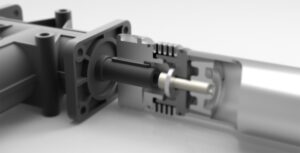By Joyce Laird, contributing editor
 All couplings relate to the connection method between the coupling hub and mating shaft. Mike Parzych, Product Marketing Manager for GAM explains that within this area, there are many things to consider when selecting the proper mating connections.
All couplings relate to the connection method between the coupling hub and mating shaft. Mike Parzych, Product Marketing Manager for GAM explains that within this area, there are many things to consider when selecting the proper mating connections.
“Keyed couplings have a key slot machined into the hub that accepts a keyed shaft which mechanically engages transmission between the connected elements, while keyless couplings on the other hand, have hubs with smooth bores and accept keyless shafts. Keyless couplings also rely on friction and clamping force transmitted between the hub and shaft through a clamping mechanism,” he says.
Advantage/Disadvantages of Each
Parzych goes on to note that keyed couplings are primarily selected for an added level of assurance that the system will function properly. “This is true because the keyed connection will inherently force transmission as well as mechanically prevent slippage. This is particularly important from a safety and security aspect for applications that involve human interaction”
He adds that keyed couplings can also provide visual alignment of drive and driven elements which can help with machine positioning. Keyed couplings can also be assembled and disassembled relatively easy as they can essentially “plug in” axially.
“However on the downside, because of this type of fit, the tolerances are less precise, which can cause several issues. Under certain conditions such as vibration, cyclic motion, and high shock loading, the key slot can deform and open up, which can introduce backlash into the system and eventually failure.”
Looking at keyless couplings, these rely on uniform clamping force along the circumference of the hub and mating shaft, imparted by a fastening mechanism, typically radial or conical bolts.
“Keyless couplings can achieve higher torque transmission as there is greater surface area for clamping compared to keyed couplings as the force is concentrated on a smaller area between the key and keyway,” Parzych says. “In addition to higher torques, keyless couplings can provide a zero backlash transmission as the rotating elements essentially become mechanically joined through the high clamping forces.”
“On their downside, in order to achieve the necessary clamping force, keyless couplings require high precision tolerancing between the hub and shaft which can make it more difficult during installation,” he adds.
Choose Carefully
In conclusion, Parzych says that as with many aspects of motion control, the advantages and disadvantages of a product may vary depending on the specific application.
“Based on the conditions as highlighted above, keyless couplings are typically recommended for high torque and cyclic applications where positioning accuracy is critical. Keyed couplings are generally used for unidirectional or continuous motion applications where safety is a priority over precision. If there is any doubt, it is always best to contact an expert in the field for the best solution.”
GAM
www.gamweb.com

Leave a Reply